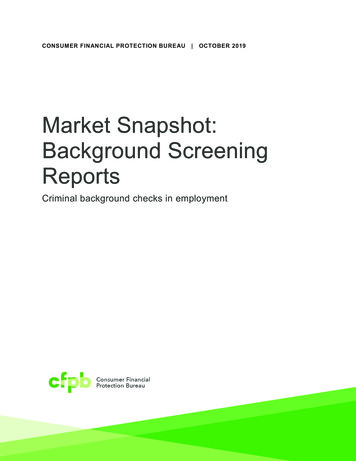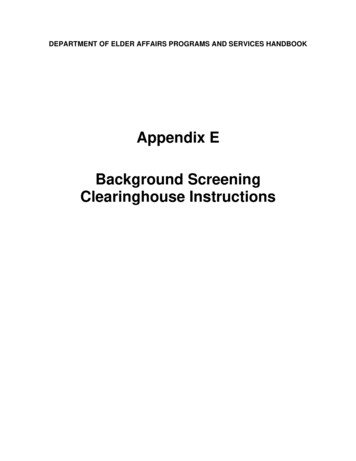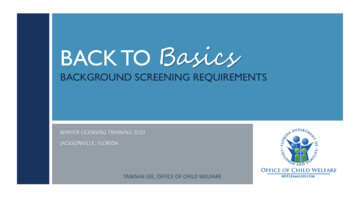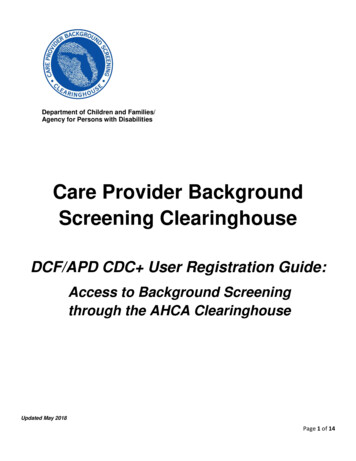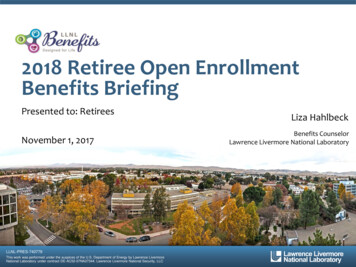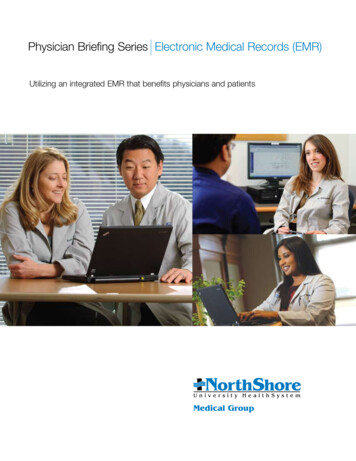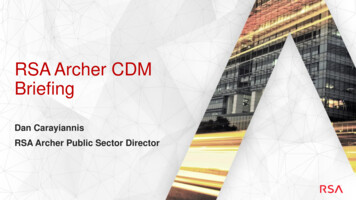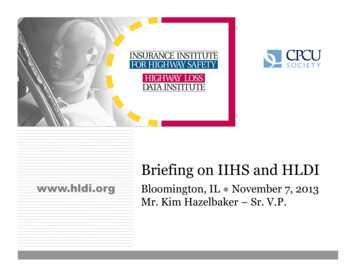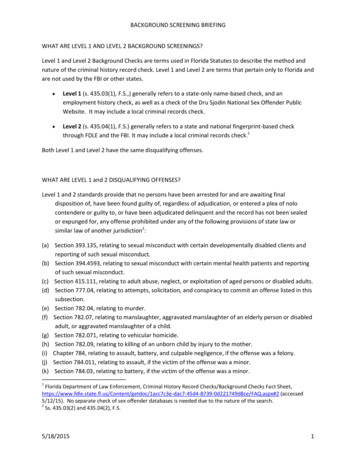
Transcription
BACKGROUND SCREENING BRIEFINGWHAT ARE LEVEL 1 AND LEVEL 2 BACKGROUND SCREENINGS?Level 1 and Level 2 Background Checks are terms used in Florida Statutes to describe the method andnature of the criminal history record check. Level 1 and Level 2 are terms that pertain only to Florida andare not used by the FBI or other states. Level 1 (s. 435.03(1), F.S.,) generally refers to a state-only name-based check, and anemployment history check, as well as a check of the Dru Sjodin National Sex Offender PublicWebsite. It may include a local criminal records check. Level 2 (s. 435.04(1), F.S.) generally refers to a state and national fingerprint-based checkthrough FDLE and the FBI. It may include a local criminal records check.1Both Level 1 and Level 2 have the same disqualifying offenses.WHAT ARE LEVEL 1 and 2 DISQUALIFYING OFFENSES?Level 1 and 2 standards provide that no persons have been arrested for and are awaiting finaldisposition of, have been found guilty of, regardless of adjudication, or entered a plea of nolocontendere or guilty to, or have been adjudicated delinquent and the record has not been sealedor expunged for, any offense prohibited under any of the following provisions of state law orsimilar law of another jurisdiction2:(a) Section 393.135, relating to sexual misconduct with certain developmentally disabled clients andreporting of such sexual misconduct.(b) Section 394.4593, relating to sexual misconduct with certain mental health patients and reportingof such sexual misconduct.(c) Section 415.111, relating to adult abuse, neglect, or exploitation of aged persons or disabled adults.(d) Section 777.04, relating to attempts, solicitation, and conspiracy to commit an offense listed in thissubsection.(e) Section 782.04, relating to murder.(f) Section 782.07, relating to manslaughter, aggravated manslaughter of an elderly person or disabledadult, or aggravated manslaughter of a child.(g) Section 782.071, relating to vehicular homicide.(h) Section 782.09, relating to killing of an unborn child by injury to the mother.(i) Chapter 784, relating to assault, battery, and culpable negligence, if the offense was a felony.(j) Section 784.011, relating to assault, if the victim of the offense was a minor.(k) Section 784.03, relating to battery, if the victim of the offense was a minor.1Florida Department of Law Enforcement, Criminal History Record Checks/Background Checks Fact 1acc7c3e-dac7-45d4-8739-0d221749d8ce/FAQ.aspx#2 (accessed5/12/15). No separate check of sex offender databases is needed due to the nature of the search.2Ss. 435.03(2) and 435.04(2), F.S.5/18/20151
BACKGROUND SCREENING BRIEFING(l)(m)(n)(o)Section 787.01, relating to kidnapping.Section 787.02, relating to false imprisonment.Section 787.025, relating to luring or enticing a child.Section 787.04(2), relating to taking, enticing, or removing a child beyond the state limits withcriminal intent pending custody proceedings.(p) Section 787.04(3), relating to carrying a child beyond the state lines with criminal intent to avoidproducing a child at a custody hearing or delivering the child to the designated person.(q) Section 790.115(1), relating to exhibiting firearms or weapons within 1,000 feet of a school.(r) Section 790.115(2)(b), relating to possessing an electric weapon or device, destructive device, orother weapon on school property.(s) Section 794.011, relating to sexual battery.(t) Former s. 794.041, relating to prohibited acts of persons in familial or custodial authority.(u) Section 794.05, relating to unlawful sexual activity with certain minors.(v) Chapter 796, relating to prostitution.(w) Section 798.02, relating to lewd and lascivious behavior.(x) Chapter 800, relating to lewdness and indecent exposure.(y) Section 806.01, relating to arson.(z) Section 810.02, relating to burglary.(aa) Section 810.14, relating to voyeurism, if the offense is a felony.(bb) Section 810.145, relating to video voyeurism, if the offense is a felony.(cc) Chapter 812, relating to theft, robbery, and related crimes, if the offense is a felony.(dd) Section 817.563, relating to fraudulent sale of controlled substances, only if the offense was afelony.(ee) Section 825.102, relating to abuse, aggravated abuse, or neglect of an elderly person or disabledadult.(ff) Section 825.1025, relating to lewd or lascivious offenses committed upon or in the presence of anelderly person or disabled adult.(gg) Section 825.103, relating to exploitation of an elderly person or disabled adult, if the offense was afelony.(hh) Section 826.04, relating to incest.(ii) Section 827.03, relating to child abuse, aggravated child abuse, or neglect of a child.(jj) Section 827.04, relating to contributing to the delinquency or dependency of a child.(kk) Former s. 827.05, relating to negligent treatment of children.(ll) Section 827.071, relating to sexual performance by a child.(mm) Section 843.01, relating to resisting arrest with violence.(nn) Section 843.025, relating to depriving a law enforcement, correctional, or correctional probationofficer means of protection or communication.(oo) Section 843.12, relating to aiding in an escape.(pp) Section 843.13, relating to aiding in the escape of juvenile inmates in correctional institutions.(qq) Chapter 847, relating to obscene literature.(rr) Section 874.05, relating to encouraging or recruiting another to join a criminal gang.5/18/20152
BACKGROUND SCREENING BRIEFING(ss) Chapter 893, relating to drug abuse prevention and control, only if the offense was a felony or ifany other person involved in the offense was a minor.(tt) Section 916.1075, relating to sexual misconduct with certain forensic clients and reporting of suchsexual misconduct.(uu) Section 944.35(3), relating to inflicting cruel or inhuman treatment on an inmate resulting in greatbodily harm.(vv) Section 944.40, relating to escape.(ww) Section 944.46, relating to harboring, concealing, or aiding an escaped prisoner.(xx) Section 944.47, relating to introduction of contraband into a correctional facility.(yy) Section 985.701, relating to sexual misconduct in juvenile justice programs.(zz) Section 985.711, relating to contraband introduced into detention facilities.S. 435.07, F.S., permits individuals generally to seek exemptions from disqualification in accordance withcriteria provided in that subsection, though other sections of law may prohibit such exemptions incertain circumstances. Disqualification may not be exempted for sexual predators, career offenders,and sexual offenders (unless the requirement to register as a sexual offender has been removed).HOW DOES BACKGROUND SCREENING THROUGH THE CLEARINGHOUSE COMPARE TO OTHERMETHODS?A fingerprint-based search of national criminal information offers the greatest amount of informationabout a person’s criminal history. There are 2 options for conducting this search in Florida (see chart).IssuePurposeWho usesthe systemWho isscreenedState Agency Screening ProcessTo exercise the police powers of the stateto establish a specific condition oflicensure or employment by a statelicensed entity.State agencies (see schedule, below)Individuals mandated by statute oradministrative rule to be backgroundscreened as a condition of employment,obtaining a state license or otherVolunteer and EmployeeCriminal History System (VECHS)3To allow voluntary screening of individualsworking with vulnerable populations whoare not otherwise required by the state tobe screened.Organizations provide “care” as defined bythe National Child Protection Act, asamended, and s. 943.0542, F.S.Employees or volunteers of organizationsthat provide “care” as defined by theNational Child Protection Act, as amended,and s. 943.0542, F.S.3The Volunteer and Employee Criminal History System (VECHS) was implemented in 1999 and is authorized by theNational Child Protection Act to provide access to both state and national criminal history information. Onlyqualified organizations (not an individual or state agency) can access VECHS.5/18/20153
BACKGROUND SCREENING vedWho can seeresultsState Agency Screening Processoperational authorization; this may includevolunteers and contractors.4. Employersmay only use the state system for thesescreenings.State and national criminal history check;basic demographic search of statedatabases for other criminal history orjudicial action not resulting in an arrest,such as recent and unprocessed arrests,open warrants, and domestic violenceinjunctionsThe state agency reviews results to see ifany disqualifying offenses are found andnotifies employer. Unless exemption fromdisqualifying offenses is obtained,individual cannot work in position.Entity authorized in statute; for child carefacilities and similar organizations, this isDCF.Ongoingmonitoringfor “hits”YesTotal stateand federalcosts perscreenVaries; for example, 22.75 for DCF and 40.50 for school district personnel andcontractors. This does not include anyapplicable retention fees, and livescanvendors may charge an additional fee.Volunteer and EmployeeCriminal History System (VECHS)3State and national criminal history record(RAP sheet) that shows arrests/and orconvictions for Florida and other states, ifany;notification of any warrants or domesticviolence injunctions that the person mayhaveNo—only the hiring entity receives resultsEntities receiving results can only showthem to other parties to VECHS system(DCF is not a party so could not see theresults of Boys & Girls Clubs screeningsthrough this system, for instance)No--VECHS background screenings providea snapshot of that person’s criminal historyat that particular point in time. It does notcover any criminal activity that may occuronce the file is completed, though thequalifying entity requesting the screeningcan ask fingerprints to be maintained forongoing monitoring pursuant to ch. 943,F.S. 38.75 for employees; 31.50 forvolunteers. This does not include anyapplicable retention fees, and livescanvendors may charge an additional fee.WHY DID THE LEGISLATURE CREATE THE CARE PROVIDER BACKGROUND SCREENING CLEARINGHOUSE?Many different agencies, programs, employers, and professionals serve vulnerable populations inFlorida and are statutorily subject to background screening. However, due to restrictions placed on the4s. 435.02(2), F.S., defines “employee” as “any person required by law to be screened pursuant to this chapter,including but not limited to, persons who are contractors, licensees, or volunteers.” For instance, s. 985.655(3)(a)requires personnel staffing DJJ contractors’ programs for children to have a level 2 screening.5/18/20154
BACKGROUND SCREENING BRIEFINGsharing of criminal history information, persons who work for more than one agency or employer orchange jobs, or wish to volunteer for such an entity, often must undergo a new and duplicativebackground screening and fingerprinting. This proves frustrating and costly to those involved.Policies imposed by the Federal Bureau of Investigation (FBI) prevent the sharing of criminal historyinformation except within a given “program.” Since each state regulatory area is covered by a differentcontrolling statute and screenings are done for separate purposes, the screenings have been viewed asseparate “program” areas and sharing of results has not been allowed. The purpose of theClearinghouse is to create a single “program” of screening individuals who have direct contact withvulnerable persons. The Clearinghouse was created under AHCA in accordance with agreements withthe FBI about the use and sharing of criminal history information.5WHAT IS THE SCHEDULE FOR AGENCIES’ JOINING THE CLEARINGHOUSE?The Care Provider Background Screening Clearinghouse (Clearinghouse) was first implemented January1, 2013. Dates agencies joined or will join are:6AgencyAgency for Health Care Administration (AHCA)Department of Health (DOH)Managed Care Health PlansVocational Rehabilitation (DOE-VR)Medicaid ProvidersDepartment of Children and Families (DCF)Agency for Persons with DisabilitiesDepartment of Juvenile Justice (DJJ)Department of Elder Affairs (DOEA)DateJanuary 1, 2013January 1, 2013November 1, 2013May 2014March 2, 2015Fully implemented by July 1, 2015 (summer camp andmental health providers are in now; others joining soon)Fully implemented by July 1, 2015Fall 2015Fall 2015OTHER THAN THROUGH THE CLEARINGHOUSE, ARE THERE ANY PROVISIONS FOR SHARINGBACKGROUND SCREENING INFORMATION?Section 402.3057, F.S., provides limited opportunities for certain individuals to avoid being rescreened:Any provision of law to the contrary notwithstanding, human resource personnel who havebeen fingerprinted or screened pursuant to chapters 393, 394, 397, 402, and 409, and teachersand noninstructional personnel who have been fingerprinted pursuant to chapter 1012, whohave not been unemployed for more than 90 days thereafter, and who under the penalty of56Bill Analysis, HB 943 (2012), House HHS Committee, published 2/17/12.Email from Molly McKinstry, Re: Care Provider Background Clearinghouse, received May 8, 2015.5/18/20155
BACKGROUND SCREENING BRIEFINGperjury attest to the completion of such fingerprinting or screening and to compliance with theprovisions of this section and the standards for good moral character as contained in suchprovisions as ss. 110.1127(2)(c), 393.0655(1), 394.457(6), 397.451, 402.305(2), and 409.175(6),shall not be required to be refingerprinted or rescreened in order to comply with any caretakerscreening or fingerprinting requirements.Based on authority in this section, DCF accepts a statement on school board letterhead that anindividual has been level 2 background screened in lieu of conducting another screening. However, thisdoes not operate in reverse—DOE cannot accept a letter from DCF attesting to a screening being done.HOW DO SCREENING STANDARDS FOR SCHOOL DISTRICT PERSONNEL COMPARE TO LEVEL 2STANDARDS?Section 1012.465, F.S. requires a level 2 background screening for noninstructional or contractpersonnel who meet certain requirements. Section 1012.56, F.S., requires that instructional personneland administrators shall not have convictions for any disqualifying offenses listed in s. 1012.315, F.S.There is no opportunity for exemption from disqualification, unlike for Level 2 screenings. The level 2screening standards are very similar to s. 1012.35, F.S., standards, though there are some differences.7Additionally, s. 1012.32, F.S., all individuals hired by a school district must be of good moral character.According to DOE, most school districts use a Level 2 background screening to determine good moralcharacter.7For example, s. 1012.35, F.S., includes as disqualifying offenses misdemeanors under s. 787.025, relating to luringor enticing a child. It also includes felony offenses under s. 794.08, relating to female genital mutilation. It doesnot include Level 2 disqualifying offenses such as s. 782.071, relating to vehicular homicide, or s. 782.09, relating tokilling of an unborn child by injury to its mother.5/18/20156
May 20, 2015 · vulnerable persons. The Clearinghouse was created under AHCA in accordance with agreements with the FBI about the use and sharing of criminal history information.5 WHAT IS THE SCHEDULE FOR AGENCIES’ JOINING THE CLEARINGHOUSE? The Care Provider Background Screening Clearinghouse (Clear
